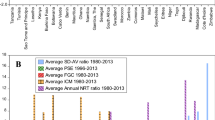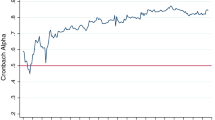Abstract
This paper elaborates upon the effect of political stability on economic growth using a novel approach. Unlike the literature on growth that emphasizes the turnover of decision makers, this paper focuses on the volatility of economic policies as the relevant indicator of stability. The literature on growth ignores the microeconomic instability associated with frequent changes of government policies. The empirical results of this paper indicate that the effect of political instability on economic growth is not conclusive. Most of the commonly used proxies for political instability have failed to explain growth differences across countries. The political instability indices have no significant effect on growth when a reasonable set of core variables is also included in the regression equation. The results also show that almost all of the policy uncertainty variables are significantly and negatively correlated with economic growth. However, the instability of economic policies has no significant impact on the accumulation of capital.
Similar content being viewed by others
References
Aizenman, Joshua; Marion, Nancy. “Policy Uncertainty, Persistence and Growth,” working paper W3848, National Bureau of Economic Research, 1991.
Al-Marhubi, Fahim. “Cross-Country Evidence on the Link Between Inflation Volatility and Growth,”Applied Economics, 30, 1998, pp. 1317–26.
Alesina, Alberto; Ozler, Sule; Roubini, Nouriel; Swagel, Philip. “Political Instability and Economic Growth,” working paper, W4173, National Bureau of Economic Research, 1992.
Alesina, Alberto; Perotti, Roberto. “Income Distribution, Political Instability, and Investment,” working paper, W4486, National Bureau of Economic Research, 1993.
Alesina, Alberto; Rodrik, Dani. “Distributive Politics and Economic Growth,”Quarterly Journal of Economics, 109, 1994, pp. 465–90.
Alesina, Alberto; Tabellini, Guido. “External Debt, Capital Flight and Political Risk,”Journal of International Economics, 27, 1989, pp. 199–220.
Banks, Arthur S.Cross-Polity Time-Series Data, Cambridge, MA: MIT Press, 1963.
Barro, Robert. “A Cross-Country Study of Growth, Saving and Government,” working paper, W2855, National Bureau of Economic Research, 1989.
__. “Economic Growth in a Cross-Section of Countries,”Quarterly Journal of Economics, 106, 1991, pp. 407–43.
__. “Determinants of Economic Growth: A Cross-Country Empirical Study,” working paper, W5698, National Bureau of Economic Research, 1996.
Benhabib, Jess; Rustichini, A. “Social Conflict, Growth, and Income Distribution,”Journal of Economic Growth, 1, 1996, pp. 125–42.
Benhabib, Jess; Spiegel, Mark. “The Role of Human Capital and Political Instability in Economic Development,” working paper, 92-24, C. V. Starr Center for Applied Economics, 1992.
Bestley, Timothy; Coate, Stephen. “Sources of Inefficiency in a Representative Democracy: A Dynamic Analysis,”American Economic Review, 88, 1998, pp. 139–56.
Borner, Silvio; Brunetti, Aymo; Weder, Beatrice.Political Credibility and Economic Development, New York, NY: St. Martin's Press, 1995.
Clague, Christopher; Keefer, Philip; Knack, Stephen; Olson, Mancur. “Property and Contract Rights in Autocracies and Democracies,”Journal of Economic Growth, 1, 1996, pp. 243–76.
Easterly, William; Levine, Ross. “Africa's Growth Tragedy: Policies and Ethnic Divisions,”Quarterly Journal of Economics, XVII, 4, 1997, pp. 1203–50.
Fischer, Stanley. “Dynamic Inconsistency, Cooperation, and the Benevolent Dissembling Government,”Journal of Economic Dynamics and Control, 2, 1980, pp. 93–107.
Glazer, Amihai. “Politics and the Choice of Durability,”American Economic Review, 90, 1989, pp. 1207–13.
Gupta, D.The Economics of Political Violence, New York, NY: Praeger, 1990.
Hibbs, D.Mass Political Violence: A Cross-Sectional Analysis, New York, NY: Wiley and Sons, 1973.
Ingersoll, J. E; Ross S. A. “Waiting to Invest: Investment and Uncertainty,” working paper, Yale University, January 1987.
International Monetary Fund.Government Finance Statistics Yearbook, Washington, DC: IMF, various.
__.International Financial Statistics, Washington, DC: IMF, various.
Jodice, David; Taylor, Charles.World Handbook of Political and Social Indicators, 3rd ed., New Haven, CT: Yale University Press, 1983.
Krugman, Paul. “Deindustrialization, Reindustrialization, and the Real Exchange Rate,” working paper, W2586, National Bureau of Economic Research, 1988.
Kydland, Finn; Prescott, Edward. “Rules Rather than Discretion: The Inconsistency of Optimal Plans,”Journal of Political Economy, 3, 1977, pp. 473–92.
Levine, Ross; Renelt, David. “A Sensitivity Analysis of Cross-Country Growth Regressions,”American Economic Review, 82, 1992, pp. 942–96.
Londregan, J. B.; Poole, K. T. “Poverty, the Coup Trap, and the Seizure of Executive Power,”World Politics, 42, 1990, pp. 151–83.
Perrson, Torreston; Svensson, Lars. “Why Stubborn Conservatives Run Deficits: Policy with Time-Inconsistent Preferences,”Quarterly Journal of Economics, 85, 1989, pp. 325–45.
Pindyck, Robert S. “Irreversible Investment, Capacity, Choice, and the Value of the Firm,”American Economic Review, 78, 5, 1988, pp. 969–85.
Rama, Martin. “Empirical Investment Equations for Developing Countries,” in L. Serven; A. Solimano, eds.,Striving for Growth After Adjustment: The Role of Capital Formation, Washington, DC: World Bank, 1995.
Serven, L.; Solimano, A. “Private Investment and Macroeconomic Adjustment: A Survey,”The World Bank Research Observer, 7, 1, 1992, pp. 95–114.
Solimano, A. “How Private Investment Reacts to Changing Macroeconomic Conditions: The Chilean Experience of the 1980s,” working paper, 212, Policy, Research, and External Affairs, World Bank, 1989.
Tabellini, Guido; Alesina, Alberto. “Voting on the Budget Deficit,”American Economic Review, 90, 1990, pp. 37–49.
Taylor, Charles L.; Hudson, Michael C.World Handbook of Political and Social Indicators, 2nd ed., New Haven, CT: Yale University Press, 1972.
Tornell, A.Real vs. Financial Investment: Toward an Explanation of Short-Termism, New York, NY: Columbia University Press, 1989.
Venieris, Y.; Gupta, D. “Sociopolitical Instability and Economic Dimensions of Development: A Cross-Sectional Model,”Economic Development and Cultural Change, 31, 1983, pp. 727–56.
__. Income Distribution and Sociopolitical Instability as Determinants of Savings: A Cross-Sectional Model,“Journal of Political Economy, 96, 1986, pp. 873–83.
White, H. “A Heteroskedasticity-Consistent Covariance Matrix Estimator and a Direct Test for Heteroskedasticity,”Econometrica, 48, 1980, pp. 817–38.
World Bank.World Development Indicators, Washington, DC: World Bank, 1998.
Author information
Authors and Affiliations
Rights and permissions
About this article
Cite this article
Ali, A.M. Political instability, policy uncertainty, and economic growth: An empirical investigation. Atlantic Economic Journal 29, 87–106 (2001). https://doi.org/10.1007/BF02299934
Issue Date:
DOI: https://doi.org/10.1007/BF02299934




